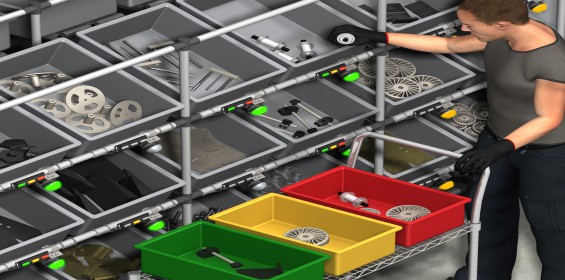Sustainability doesn’t have to come at a cost, in fact many companies are finding that their initiatives are saving them money. Turck Banner has identified three broad areas where they can assist companies in saving costs as well as becoming more sustainable. Production efficiency, energy management and supply chain management.
Increasing yields in meat processing
A large meat processing company supplying meat products to over 50 countries
have teams of highly skilled butchers, processing over 4,000,000 sheep and cows per year. As every butcher and every animal is unique, achieving the highest meat yield from each animal takes skill. To identify which butchers achieve the highest yields, every animal is tracked throughout the whole butchery process using RFID tags embedded in the containers which carry the parts. At every stage the bone and fat removed are put into separate containers which are also tracked and weighed. At the end of the process the exact amounts of the retail meat, fat, bone and any other waste is known for every animal. This data also shows which butchers are able to achieve the highest yields from which areas of the animal. Utilising this information allows butchers to be placed where they are most productive and to pass on their skills to other butchers.
Higher yields ultimately result in less waste, less animals required, and with less time and energy spent producing the retail product.
Increasing efficiency in assembly stations
Assembly station workers need both a constant supply of parts and somewhere to put the completed product. Both are equally important to maintain maximum efficiency. Empowering operators to call for parts and collection when they feel it necessary is the first step in maintaining optimal production speeds. However, with no acknowledgement that the request has been received, and that a forklift or AGV is on its way, the “call” is often far too early, resulting in congestion around the workstation which slows production. By utilising wireless illuminated touch buttons which change colour to indicate progress, the operator receives direct feedback regarding all stages of the assembly. Illumination is off at the beginning and end of the process and changes colour with each step, firstly indicating that the button has been pressed, then that the AGV is in transit. Finally, the operator touches the button to acknowledge the AGVs arrival with parts, or its departure with a pallet of completed products. Timed data from each button press, combined with detection of each completed part provides the data required to allocate resources and optimise manufacture. Wireless communication and position tracking between the AGV and workstation enables the system to direct the AGV in the most efficient pattern.
This not only results in increased productivity but mileage on the AGVs and forklifts is also reduced, saving energy and maintenance costs.
Edge Guiding to reduce waste
The delicate clear film used in dye sublimation printing must be handled very carefully, as any blemishes in the film will be transferred to the printed images. The film must be guided very precisely to avoid wrinkles or tears but if the detection method is too close there is a risk that the film may be damaged by touch. A special low contrast light curtain placed up to 375mm away from either side of the film can precisely detect the clear edge and issue instructions to gently guide the material through the machine. The same light curtain is used in carpet manufacturing to detect the two-edge transition on the carpet web. The first transition is air to selvage (the substrate material of the carpet), the second transition is selvage to tufting. Automatically measuring and adjusting these transitions as close to the tufting process as possible greatly reduces any waste that previously occurred in post manufacturing inspections.
Pick-to-light to eliminate picking errors and reduce product returns
The correct supply of a modular product requiring a specific attachment from hundreds of nearly identical attachments, to fit something that their customer already owns is a challenge. For example, supplying roof bars with the correct fitting for one of thousands of different car models and makes. The chance of picking wrong parts in a continuous steam of orders, each requiring different combinations of parts, is extremely high. Ensuring correct parts are picked from a paper list is a very slow process and still prone to errors. Turck Banner has seen this problem in industries ranging from car accessory manufacturers to fast food outlets. Pick-to-light systems solved the problem in almost all cases. One such system involved installing devices with both a bright indicator and a numeric display on over 400-part locations. When each operator was assigned their own colour all they had to do was see which location was illuminated in their colour, and pick the quantity displayed on the device. After touching the illuminated button to acknowledge that the part(s) had been picked, the system would then illuminate the next location in the order sequence.
Unlike the old paper list that would be picked in the order it was printed, the system chooses a pick sequence to minimise the distance that the operator has to move and sequences the heavy or bulky items last. Orders are picked more quickly, with no errors, resulting in far fewer returns. This in turn reduces transport costs and pollution etc. Not printing picking lists saves on paper and printer ink, filing and recycling.
These are just four examples where careful investment in the right products can have a significant impact on both short- and long-term savings, at the same time making the product or process more sustainable.
https://twitter.com/TurckBannerUK
https://www.linkedin.com/company/turck-banner-ltd/

